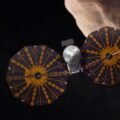An international team of researchers says they have discovered a new variety of quantum vortex that occurs within superconductors, pointing to a previously unknown circulatory phenomenon.
Superconductivity is the property some materials possess where electrical resistance is negated—that is, they can conduct direct current electricity without losing energy—below a certain “critical” temperature. Equally, magnetic fields are expelled by superconductive materials when their sudden transition to this superconducting state occurs.
When superconductivity occurs in these materials, small cyclones of electrons are generated, a phenomenon known as quantum vortices, which researchers recognize as having significant applications in the development of technologies that include quantum sensors.
Now, in a breakthrough discovery, an international research team reports the discovery of a novel kind of superconducting vortex that potentially reshapes our current understanding of the phenomenon that occurs within superconductors, upending previous ideas and paving the way toward new innovations in computing and electronics.
The new observation was an outgrowth of a 2003 Nobel Prize award-winning study involving quantum vortices, which builds on those discoveries and reveals that the magnetic flux produced by these vortices (the same outflow of magnetic fields that occurs once critical superconducting temperatures are reached) are capable of a greater degree of division than past observations had determined.
KTH Royal Institute of Technology in Stockholm professor Egor Babaev, who worked alongside colleagues at Shanghai’s TD Lee Institute and AIST in Tsukuba, Japan, and researchers from Stanford University, said the team’s findings help to reshape common ideas about the flow of electricity within superconductors.
Whenever magnetic fields from outside a superconductor move close enough to interact with it, a vortex of magnetic flux occurs as the field penetrates the material, forming vortices from the resulting quantized magnetic flux tubes. Previously, these vortices were each believed to possess one quantum of magnetic flux since it had not been previously considered whether fractional degrees of this quantum flux could be possible.
Stanford University possesses a special variety of magnetometer used to measure the weakest magnetic fields, which occur in relation to superconducting loops containing layers of superconducting material separated by thin layers of resistors, otherwise known as Josephson junctions.
This Superconducting Quantum Interference Device, or SQUID, at Stanford University, is capable of measuring incredibly weak magnetic fields, which allowed Professor Kathryn A. Moler and research scientist Yusuke Iguchi, two of Babaev’s co-authors, to discern the existence of quantum vortices within a single electronic band.
Along with their success in showing these behaviors at the microscopic level, the team also demonstrated the creation of fractional quantum vortices and their movement.
Moler, a physicist and current Dean of Research at Stanford University, said that Babaev had spent years explaining that this could be achieved.
“I didn’t believe it until Dr. Iguchi actually saw it and conducted a number of detailed checks,” Moler said in a recent statement announcing the team’s discovery. Moler added that she has observed “vortices in novel superconductors for over 25 years, and I have never seen this before.”
According to Iguchi, the phenomenon the team observed was deemed “incredibly uncommon,” prompting them to repeat the experiment more than 70 times under various temperatures and in multiple locations.
“That revises our understanding of quantum vortices in superconductors,” says Babaev, whose previously published work close to two decades ago found that similar circulating vortex phenomena involving electrons had been observed in certain varieties of crystals.
Babaev and the team believe their observations could yield new technological applications, including the conveyance of information in superconducting computers.
Babaev says that the robustness of quantum vortices and the possibility of controlling them suggests that quantum vortices could potentially be used as information carriers in superconducting components within quantum computers in the years ahead.
The team’s paper, “Superconducting vortices carrying a temperature-dependent fraction of the flux quantum,” appeared in the June 2023 edition (Vol. 380, Issue 6651) of Science.
Micah Hanks is the Editor-in-Chief and Co-Founder of The Debrief. He can be reached by email at micah@thedebrief.org. Follow his work at micahhanks.com and on Twitter: @MicahHanks.

